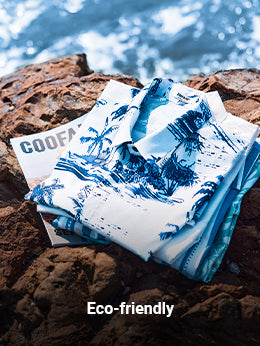A Guide to Caring for Your Sweaters

Navigation
- How often to Wash Your Sweaters?
- Washing: Treat Sweaters with Care
- Drying: Reshape and Allow to Air Dry
- Storing: Fold Properly and Use Cedar
- Dealing with Pills, Holes and Stains
- When It's Time to Toss an Old Sweater
A quality sweater is a wardrobe staple most men rely on once the cold weather hits. But to keep your sweater collection looking sharp season after season takes knowing how to care for them properly. Don't just toss those cashmere, wool, and cotton knits into the wash and hope for the best! Follow this simple guide to sweater care and you'll get more mileage out of your trusty knits.
How often to Wash Your Sweaters?
The question ask most often by people is how often should we wash our sweaters. When it comes to laundering your sweaters, it's important not to overwash them. Too much washing, especially with harsh detergents or high heat, can cause shrinking, distorting, pilling and other damage over time.
Follow these general guidelines on how often you should be washing different types of sweaters based on their materials and usage:
- For delicate cashmere sweaters, limit washing to only once or twice per season. These luxury knits are best cared for by spot cleaning when possible.
- Wool sweaters can typically go a few months between full washes. Simply airing them out and spot treating stains in between wears helps maintain their integrity.
- Plan to launder cotton sweaters every 5-6 wears. Cotton is more durable than wool or cashmere, but still benefits from gentle, infrequent washing.
- Acrylics and polyester can sometimes be worn 10+ times before requiring a full wash cycle. These synthetic fibers are less prone to shrinkage from frequent washing.
- Sweaters worn as outer layers need more frequent cleaning, about every 3-5 wears since they're exposed to more elements.
- Sweaters worn directly against skin as base layers should be washed about every 2-3 wears since they absorb sweat.
- And performance workout sweaters should be laundered after just 1-2 active wears to remove absorbed odor and oils.
No matter the sweater, inspect for visible stains or odors and launder as needed, even after just one wear if heavily soiled. With care and discretion, your knitwear can maintain its beauty season after season.

Washing: Treat Sweaters with Care
Knit fabrics are delicate and can easily stretch out of shape, shrink, or pill if not properly washed. While throwing them in with the regular laundry may seem quick and convenient, taking a few extra steps to wash them gently will extend their lifespan and ensure they stay soft and retain their shape.
The first key is to use a detergent specifically formulated for delicates and woolens.
- Use a gentle, wool-specific detergent. Look for detergents labeled for "woolens" or "delicates". Avoid regular detergents which can be too harsh on wool fibers.
- Opt for a liquid detergent over powdered. Liquid detergents tend to be more gentle and dissolve better in cool water.
- Only use a small amount of detergent. Too much can leave behind soap residue which is difficult to rinse out. Start with 1-2 tablespoons in a standard load.
- Skip the fabric softener and dryer sheets. These can coat fibers and diminish the natural properties of wool.
Secondly, wash knits in cool to lukewarm water. Hot water can cause wool fibers to shrink or felt. Check clothing tags for specific temperature recommendations.
Additionally, it's smart to hand wash. Or if machine washing, always use the gentle or delicate cycle and cold water setting.
When rinsing, don't wring or twist sweaters to extract moisture. Simply press down very lightly to expel water, then lay flat immediately after to dry. Taking great care when washing preserves your sweater's shape and quality.

Drying: Reshape and Allow to Air Dry
The key to properly drying sweaters is reshaping them during the drying process and allowing adequate time to fully air dry.
Lay sweaters flat on top of a dry towel or on a mesh drying rack. As the sweater dries, gently smooth out any areas that have become misshapen or stretched. Periodically stretch and shape the sweater back to its original dimensions.
For heavier knit sweaters like wool, support the weight by reshaping over a towel rack or on drying forms to avoid sagging. Lightweight cotton or synthetic blend sweaters can be laid flat or draped over a hanger.
Never place wet sweaters directly into the dryer, as the heat and tumbling might damage fibers and cause shrinking. Allow sweaters to completely air dry before wearing or storing. Rushing the drying process can irreversibly distort shape, so be patient.
Storing: Fold Properly and Use Cedar
When it's time to put away sweaters for the warmer months, folding them is the way to go for maintenance of shape and size. Before folding, gently reshape any areas warped from use and allow the sweater to fully dry.
Carefully fold along the sweater's seams and lines to avoid imprinting creases. Store properly folded sweaters in breathable storage bins or fabric containers, avoiding airtight plastics which trap moisture.
For extra protection, add cedar blocks or natural herb sachets inside the containers to deter moths and other damaging pests. This preserves your knits over the off-season months.

Dealing with Pills, Holes and Stains
It's inevitable that with repeated wear, your favorite sweaters will accumulate some pills, small holes, or the occasional stain. Don't fret! These issues can be remedied with some care.
For pill removal, use a specialty fabric shaver or sweater stone designed for knits. Gently groom any pilled areas according to product instructions. For minor holes, weaving in yarn using a darning method can provide an invisible mend. Larger holes may require a patch.
As for stains, pretreat spots before washing using dish soap, baking soda or other recommended solutions based on the stain type. With some patience, you can keep sweaters looking fresh.
When It's Time to Toss an Old Sweater
Of course, there comes a point where a sweater has endured one too many washes or seasonal moth snacking. It can be tough to say goodbye, but if a piece has substantial hole damage, major shrinking issues or stubborn stains that can't be remedied, it may be time to retire it from your wardrobe.
For sweaters still intact enough to wear, consider donating to charity so they can find new life with someone else. Or look for textile recycling options which turn old sweaters into insulation and other materials. This way, you keep them from landfills.
With proper seasonal care for washing, drying, mending and storing your sweaters, you can add years to their lifespan. Follow these tips and you'll always have a sweater collection ready to provide comfort and stylish warmth.































